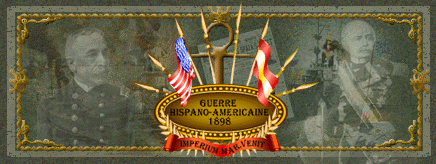
USN and Armada, context, developments, battles.
- Aragon class cruisers (1879)
- Battle of Manila May, 1, 1898
- Battle of Santiago de Cuba (july, 3, 1898)
- Cristóbal Colón (1896)
- Emperador Carlos V
- Infanta Maria Teresa class cruisers (1890)
- Pelayo (1887)
- The Spanish-American War of 1898
- USS Brooklyn (1895)
- USS Charleston (1888)
- USS Iowa (1896)
- USS Maine (1889)
- USS Olympia
- Velasco class cruisers
How the “splendid little war” began
As we know, this war began with the blowing up of the USS Maine in Havana harbor. The explosion later formally identified it as accidental, but the American public then has been pushed “white hot” by the press and recent events, such as the Cuban rebellion led since 1869 against Spanish occupation. Cuba was the last of its former South American colonial empire, shattered by revolutions following Simon Bolivar epic. Spain clung to her last possessions (including the Philippines) in 1897.

USS Maine, author’s illustration
The accident was actually interpreted as a Spanish sabotage, and United States declared war on Spain April 25, 1898, two months after. Originally the Maine has been sent in the harbor of Havana, in order to recover US citizens informally possibly threatened by the general insurrection. Insurgents were then supported covertly by the United States. That bad fortune bring the Casus Belli the Americans waited for. To date, the hypothesis of an accidental explosion of the forward ammunition magazine is accepted my mainstream historians.
President McKinley, without formal proofs, but backed by the press and Congress, had accused the Spanish local authorities of sabotage, making it a perfect Casus Belli. Operations soon started, after a failed negotiation for a Spanish withdrawal from Cuba, naturally refused. Admiral Sampson began a blockade of the North coast of Cuba, preventing the arrival of reinforcements.
Far away though, on 1 May 1898, the U.S. Pacific Fleet attacked the Spanish fleet in the harbor of Manila, the Philippines, under the command of Admiral Montojo, and crushed it without a single loss, to prevent reinforcements from the Spanish Pacific and threatening Spanish colonial interests in the area. The Atlantic Fleet was responsible for the area of Santiago de Cuba, when Cervera’s squadron came from Spain with reinforcements, trying to break the blockade when took place the famous battle of San Juan.

Cruiser Vizcaya. To support its fledgling empire, the Armada (Spanish Navy) was on paper twice as large as the US Navy back in 1898. She was however only a shadow of its former glory, and the total defeat suffered mirrored the crippling Russian losses at Tsushima six years later. New powers challenged old Europe.
This was a disaster for the Spanish navy, which lost its main armored cruisers, and more than half of the fleet. Peace was signed in Paris December 10, 1898. The United States emerged as a protectorate over Cuba, bases in Puerto Rico, Guam, the Philippines, and especially Hawaii, the future headquarters of the Pacific Fleet. This was the beginning of the American “imperialism”.
The US Navy in 1898
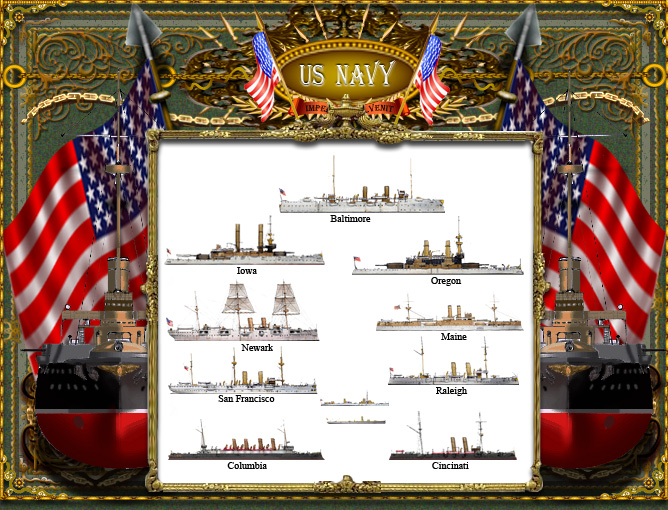
There are two basic major periods to qualify the United States Navy in the nineteenth century: There is the “Old Navy”, which included ships from some of the wars of independence against England in the Napoleonic era, ships as old as the USS Constitution (“old Ironsides”, 1797), but also all vessels originally designed before, during and after the Civil War of 1861-1865. One thing was sure, the finances of the United States after the secession war did not allow to built a Blue Water Navy to speak of: The years 1870-80 were years of crisis.
It was not until 1890 a semblance of rebirth of what is now called the “New Navy” began, under the influence of thinkers like Mahan and prominent Republicans like “Teddy” Roosevelt. Almost all the remaining units of the Old Navy would be scrapped and a few survivors of the 1870s served as depot or training ship.
From the rebirth of the “Navy” to 1898, it will take eight years, used to provide a real potential and eventually resort as more than a match for its Spanish opponent.
| Types |
USA |
Spain |
| Ironclads | 0 | 5 |
| Cruisers | 3 | 17 |
| TBs | 2 | 16 |
| Gunboats | 3 | 43 |
| Miscellaneous | 32 | 3 |
*Small table comparing American and Spanish navies in 1890: It shows the overwhelming Spanish superiority.
* While the two fleets have submersibles, in 1898, they are not included in this table for obvious reasons: At that time it was experimentation: Their military value was purely theoretical.
| Types |
USA |
Spain |
| Battleships | 6 | 4 |
| Armoured Cruisers | 2 | 6 |
| Cruisers | 15 | 18 |
| Destroyers | 0 | 6 |
| TBs | 5 | 13 |
| Monitors | 6 | 0 |
| Gunboats | 16 | 43 |
| Miscellaneous | 20 | 3 |
As can be seen, the superiority of the Spanish navy in 1898 is still obvious, at least on paper. But on the battleships, one is truly “modern”, although its design dates back, the Pelayo. In contrast, American battleships are recent and of good quality, which gives a real balance of power 6 to 1. The same applies to the cruisers. Those aligned by Spain are older than ten years and so small that they could be likened to gunboats.
However the American domination in monitors is of little interest in the conflict of 1898, this type of vessel being recorded in coastal defense, not to distant operations, like the whole of American TBs. The apparent dominance of Spain in gunboats also illusory: Thirty of them are small colonial units of less than 100 tons and lightly armed, those of high seas being over-age, while the U.S. units are modern, powerful and designed for the high seas. What is quite instructive in this regard: When the Americans took possession of protected cruisers Spanish Isla de Cuba and Isla de Luzon, they were reinstated in the Navy as gunboats (See fact sheets on the Battle of Santiago and the Raid of Manila).
Battle order of the US Navy in 1898
6 Battleships:
Unquestionably, the highlight of the Navy. They were known to be slower than the armored cruisers, but proved fast enough in front of the old Spanish buildings poorly maintained. There were Texas, Maine, the three Indiana, Iowa. Two other (class Kearsarge) were completed, three (class Illinois) under construction, three more (Class Maine (2)) Scheduled for 1899. The name “Maine” was given shortly after the loss of the first in Havana. Texas, Indiana, Oregon, Massachussetts, Iowa, were all present at the battle of Santiago.
6 Monitors: There were 12 already in service from the end of the Secession war, relegated as second-class monitors. They are bottom of the list. The only monitors worthy of the name in the Navy buildings were modern and high water if able to cross the Atlantic. They were the USS Puritan (1882), initiated in 1876 and completed much later, in 1896. In terms of weaponry, she had the value of a battleship. The four Amphitrite (1896) were in the same case. Finally, the Monterey was in cons but is started in 1889 and completed in 1893. So she was more modern. All of them were much higher than the Puigcerda, who also served as a training ship in 1898. They hardly took part in any act of war but did patrolled.
2 Armored cruisers: Relative disadvantage because the Navy had only two, the USS New York, flagship of Commodore Sampson in the Battle of Santiago, and the USS Brooklyn, flagship of Schley at that battle. The Brooklyn distinguished herself while USS New York, absent from the combat, is practically not involved. Compared to Spanish ships, they were more recent, more accurate, fast but relatively less well protected. In battle a duel to the death between the Brooklyn and Viscaya, ended in the destruction of the latter.
15 Cruisers: Apparent inferiority also the Navy, at least on paper. As noted above, the Spanish units from the 1880s would be classified as “gun” in the Navy. Only Alfonso XII and Reina Regente could bear comparison. They were sometimes old ships, like the two Atlanta (1884), Chicago (1885), Charleston (1888), the Newark and San Francisco (1889), and other more “modern” as the two Baltimore (1888), Olympia (1892), both Cincinnati (1892), the three Montgomery (1893), both Columbia (1893). For good measure, two summers had ordered an emergency at the deteriorating relations between the United States and Spain to Britain, to Armstrong projects, both New Orleans. They will be accepted for service in 1898 (but too late to serve during the war) and 1900. Most distinguished themselves during the great raid on the Philippines in May 1898. In pure tonnage, in armament, quality and modernity, the report was totally in favor of the Navy.
No Destroyer so far: The USS Farragut was the first. In 1898, she was under construction. She will be launched in July 1898 and completed in March 1899. The Armada had an incontestable advance in this field.
5 TBs: All Torpedo Boats were of local construction and new, their military value was greater than their Iberian antagonists at least on paper. However, they played no role in the campaign, because of coastal nature and limited range. These were the old Stiletto (1886), Cushing (1890), Ericsson (1894), two of the Foote class (1897), a third would be accepted for service in mid-1898. Several others would be operational before the end of the war, whereas new orders were placed. In total 35 boats would be accepted until 1905.
1 Submersible: The Holland (1897), probably the most famous Anglo-Saxon submarine, was just tested in 1898. She was revolutionary at the time, designed by John Holland, who created a few years later Electric Boat to mass produce these, today’s still the largest manufacturer in the world in this field. She was already more reliable and efficient than the experimental Spanish submarine Isaac Peral.
20 Miscellaneous ships: This is difficult to classify these ships, due to their typology: The most recent and interesting were the USS Kathadin ramming cruiser, launched in 1893 and inspired by ships developed by France and Britain. At this time of passion for antiquity, the spur was favored to the extent that we designed units specifically dedicated to this purpose. The other ship is the only pneumatic guns gunboat/cruiser that ever existed: The USS Vesuvius. She bombarded the port of Santiago de Cuba, but this was her only military action.
Moreover, the lists still included number of older units, used mostly as a training ships, old monitors, used as second-class coastal units, eight of the Passaic class, four of Canonicus class, old sailing sloops, two of the Galena class, USS Marion, Mohican (1876 -85), the first a naval militia school and the second as a more advanced training ship, four Enterprise Class (1874-78), three of which served as training ships, the Alliance, Enterprise, and Essex, and the Adams as a patrol ship, two of the Alert class, and one Ranger, also a patrol ship. All were composite ships (rigging and steam) and low military value.
Requisitions:
In this chapter, detached from the comparison table above as specially chartered for the war and only during that one year of the conflict are different units, armed in haste to the declaration of war: These were the auxiliary cruisers USS (former SS) Saint Paul and Saint Louis, liners of 1894-95, 15,000 tonnes, well armed.
The USS Harvard and Yale (1888), also well armed. They are also the steamers Badger, Buffalo, Dixie, Panther, Prairie, Yankee, Yosemite, dating from 1889 to 1893 and renamed, and converted Yachts as Auxiliary patrol ships (although their speed allows them to be used as scouts), the Dorothea, Eagle, Gloucester, Hornet, Mayflower, Scorpion, Vixen and Wasp (renamed and recent, 1890-1898). They played a definite role in the Battle of Santiago as they accompanied the squadrons of Sampson and Schley on the wings. The Vixen was used as a dispatch vessel with the Admiralty and Schley and Samspon, while USS Gloucester moan down Spanish destroyer Pluton with her two QF 57 mm guns.
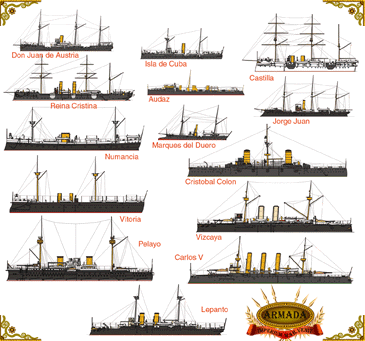
Spanish Armada
THE ARMADA (1898)
Well above the U.S. Navy in the 1870s to the 1890s, the Spanish Armada was a serious adversary for a new, still green “New Navy”, and its handful of modern units. In gross tonnage, the Armada was largely on paper over, and the seventh largest in the world (behind the British, French, Russian, German, Italian and Japanese Navies of the time). She was at least equally impressive in 1870, counting seven ironclads, many ships of the line, large frigates and sloops.
Its huge colonial empire, the second behind Great Britain then extended over part of South America but also the Caribbean, Far East and Pacific. Following the epic of Simon Bolivar’s revolutions, Spain gradually lost in the early nineteenth century her main colonies of South America and only remained Cuba in 1898, controlling its possessions in the Caribbean, but also the Philippines in the far east, and also Guam in the Pacific, the Mariana and Carolina Islands being recently purchased by Germany. Her fleets from 1876 were stationed in the Metropolis (Cartagena), on her possessions in the Caribbean in Cuba (Havana) and one fleet was stationed in the the Philippines also guarding her possessions in the Pacific (Manila).
Financial situation deteriorated as an echo of an internal quite turbulent political situation, making Spain an easy victim for the nascent colonial ambitions of the United States, which reach their climax with the election to the White House of George Mc Kinley. Many American businessmen, who have financial interests in Cuba, and support the local insurgents, are actively lobbying for the war and working in secret to find a flaw.
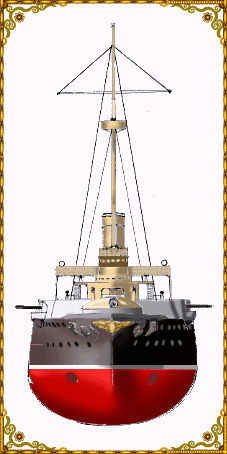 This was an unexpected accident, immediately exploited by the press, giving a perfect casus belli: The explosion of the Maine in Havana harbor. The case, probably an accident, became a deliberate attempt of hatred Spain authorities against the American people. The rest is history: the Pacific Fleet (Montojo) of the Philippines was wiped out on May 1 and the Cuban release fleet of Admiral Cervera was defeated July 3, 1898. In a quick succession, the “pearl of the empire” and the bulk of the Spanish colonies in the Pacific (including Guam) fell to the Americans, now “protectorates”, with new precious bases and strategic resources for an expanding naval power.
This was an unexpected accident, immediately exploited by the press, giving a perfect casus belli: The explosion of the Maine in Havana harbor. The case, probably an accident, became a deliberate attempt of hatred Spain authorities against the American people. The rest is history: the Pacific Fleet (Montojo) of the Philippines was wiped out on May 1 and the Cuban release fleet of Admiral Cervera was defeated July 3, 1898. In a quick succession, the “pearl of the empire” and the bulk of the Spanish colonies in the Pacific (including Guam) fell to the Americans, now “protectorates”, with new precious bases and strategic resources for an expanding naval power.
Armada – Battle order in 1898
-3 Battleships :
A single modern battleship, the Pelayo and two older Ironclads, Numancia and Vitoria, recently overhauled in France, and the very old Mendez Nuñez. Only the first was of a real fighting value, although ranked second class, with a configuration in lozenge unlike British battleships, the others being in a hypothetical “third class”. The Mendez Nuñez, dating back from 1869, was in reserve, used as an officer floating mess and HQ. The Numancia and Vitoria dating from the 1860s, were relegated to coastal defense and none were near to their U.S. counterparts, brand new battleships.
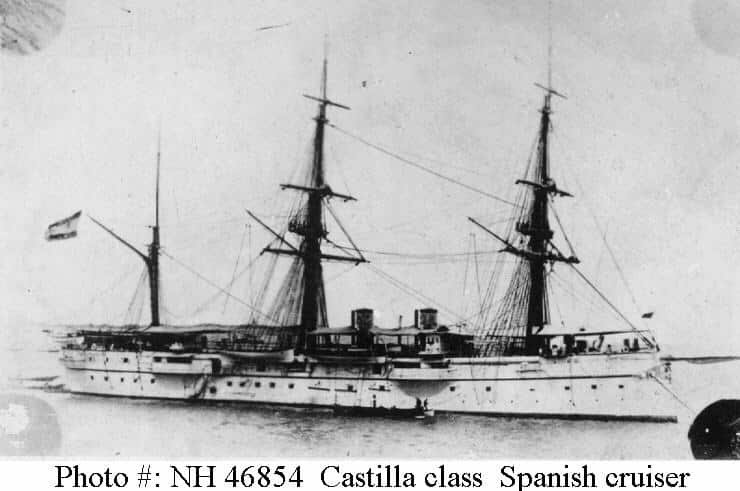
Cruiser Castilla
5 (6) armored cruisers: They are undoubtedly the backbone of the Spanish Navy: These were the Infanta Maria Teresa class (3), the Cristobal Colón (former Italian), and Emperador Carlos V (being tested), while three others were being completed, the class Princesa de Asturias. Only the first was completed, although other sources speak of a final commissioning in 1902, due to extensive testing. But it was afloat in 1898 and adapted to receive the crews. However it was doubtful that it can be operational in time, except in emergencies.
18 Cruisers: This was first of the recent class ships Reina Regente (3), Alfonso XII (3), and oldest 2nd class Isla de Luzon (3), Velasco (6), and Aragon (3). In addition, the Rio de la Plata was under construction in France, and was scheduled to Estramadura Ferrol in 1899.
12 Torpedo Gunboats: This were more precisely the Destructor (1886), Filipinas (1892), the 7 Temerario (1889-1891), and 3 Doña Maria de Molina (1896-1897), brand new, then on trials.

Reina Cristina. She was one of the numerous cruisers and ironclads the Spanish fleet was made of, a former glory of what remained the “Armada” which used to be the most powerful navy in the world during Charles V reign. However, if on the paper this fleet was numerically impressive, ironclads were at best only good for coastal defence, some of the cruisers (like this one) were unarmored and sometimes even unarmed, with obsolete guns, depleted or ill-trained crews, poorly supplied and commanded, but not lacking bravery in any aspects.
6 Destroyers: Some ships of English origin (Two of Furor class) and built in spain (the Audaz 4), brand new.
15 Destroyers: They were older (1878 to Castor, French origin) to 1887 (Ejercito, German original), commanded by unit or in two different sites, mostly British.
1 Submersible: Isaac Peral (1888), named after the talented Jewish engineer who conceived her, preceded by Ictíneo, Narciso Monturiol in 1859. It goes without saying that the Peral was strictly coastal and experimental.
37 Gunboats: Sailing sloop Jorge Juan (1876), gunboats Class Fernando el Catolico (2) and those of class General Concha (4), plus thirty light colonial gunboats 2nd class (less than 100 tonnes and a single gun), the Alvarado, Albay, Alsedo, Almendares, Arayat, Calamianes, Callao, Cocodrilo, Contramaestre, Criolo, Cuba Espanola, Diego Velasquez, Eulalia, Ferrolano, Flecha, Fradera, Glacela, gaditano , Indio, Leyte, MacMahon, Manileno, Mariveles, Mindanao, Mindoro, Pampanga, Panay, Paragua, Pelicano, Pilar, Ponce de Leon, Prueba, Salamandro, Samar, Sandoval, and telegramma.
The USN in 1898
USS MAINE (1895)

This was the second battleship to enter US Navy service in 1895 was built at NY navy Yard from 1888 to 1889 from a Samuda design originally made for the Brazilian Riachuelo. It was considered not a proper battleship but more a heavy armoured cruiser. Although not a satisfactory design, being a “second rate” battleship, the Maine kept the Echeloned turrets seen in the previous USS Texas, but with more space between them. It was sent to be anchored at La Havana harbor, “showing the flag” during the Cuban revolution. After three weeks it blew up under circumstances which has been clarified far later as an accident in forward magazines, but was also instrumental to forge a casus belli as the Spanish were accused.
- Weight & dimensions : 6682 t (7180 t FL); 97,23 x 17,37 x 6,55 m
- Propulsion : 2 shafts VTE, 4 cyl Boilers, 9000 hp, 17 knots.
- Armour : Harvey belt 12in, barbettes 12in, turrets 8in, CT 10in
- Armament : 2×2 10in (254 mm), six 6in/30 (152 mm), 7-6pdr (57 mm) and four 356 mm sub TT.
- Crew : 374
USS NEWARK (1890)
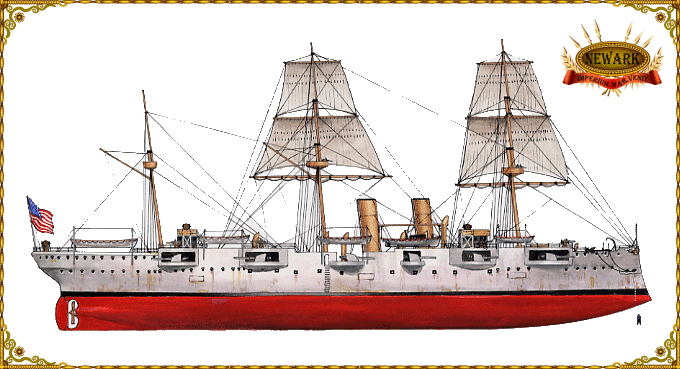
Being officially the C1, first cruiser of a very long line in the US Navy, the Newark was mostly based on a previous steam-and-sail vessel, USS Chicago, and relatively conservative in its design although more successful. With a better protective deck, the Newark was more successful than the Chicago, laid down 6 years before. She was rigged as a barque but the sails were soon removed. She played no active part during the 1898 war and was stricken in 1913, serving as a quarantine Hulk at Providence until being sold in 1926.
- Weight & dimensions : 4083 t (4592 t FL); 99,97 x 14,98 x 5,74 m
- Propulsion : 2 shafts HTE, 4 cyl Boilers, 8500 hp, 18 knots.
- Armour : Complete 2in and 3in amodship protective deck, CT 3in
- Armament : Twelve 6in/30 (152 mm), 4-6pdr (57 mm), 4-3pdr (47 mm) and 2-1pdr (37 mm) QF guns.
- Crew : 374
USS CINCINATTI (1892)
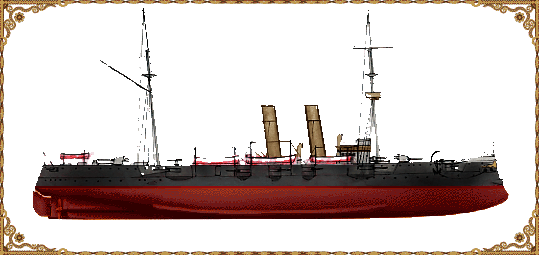
Authorized in 1888, these two cruisers were loosely based on the classic Armstrong-Elswick style export cruiser. But they had a single 6 inches gun and her 5in were not as efficient. Commissioned in 1895, they played no active part in 1898 battles. These two small and relatively fast cruisers built in NY navy yard and Norfolk were originally rigged but their fore and aft sails were removed in 1899.
- Weight & dimensions : 3183 t (3339 t FL); 93,13 x 12,80 x 5,49 m
- Propulsion : 2 shafts VTE, 6 cyl Boilers, 10 000 hp, 19 knots.
- Armour : Complete 2in and 2,5in amidship protective deck, CT 2in
- Armament : One 6in/30 (152 mm), 10x5in (127 mm), 8-6 pdr (75 mm), 2-1pdr (37 mm) QF guns, four 457 mm TT sub
- Crew : 322
USS SAN FRANCISCO (1890)
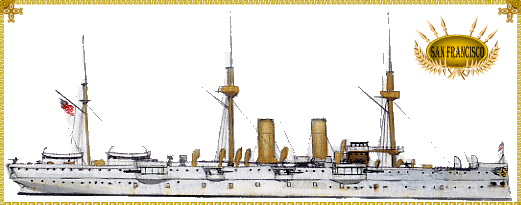
Almost a sister-ship to the USS Newark, the San Francisco was rigged as a three masted schooner. Its fore and aft 6in guns were not mounted in sponsons, but on the forecastle and poop, but they were rearmed in 1902-03. She was built at Union Iron works, the keel laid down in august 1888 and commissioned in november 1890. She played no major part in the 1898 war and was used as a minelayers in WW1, decommissioned in 1921 and stricken in 1939.
- Weight & dimensions : 4088 t (4583 t FL); 98,91 x 14,98 x 5,74 m
- Propulsion : 2 shafts HTE, 4 cyl Boilers, 10 500 hp, 19 knots.
- Armour : Complete 2in and 3in amidship protective deck, CT 3in
- Armament : Twelve 6in/30 (152 mm), 4-6pdr (76 mm), 4-3 pdr (47 mm), 2-1pdr (37 mm) QF guns.
- Crew : 384
USS STILLETTO (1890)

This very first American torpedo-boat was purchased after completion by Herreshoff as a private speculation, in 1887. Built in wood, she was fast but unreliable and mainly used for testings. An experimental, wooden hulled torpedo-boat, using coal.
- Weight & dimensions : 31 t; 28,64 x 3,50 x 0,91 m
- Propulsion : 1 shaft VC, 1 Almy Boiler, 359 hp, 18,2 knots.
- Armour : None
- Armament : Two Howell torpedoes for trials.
- Crew : 384
USS TEXAS (1892)
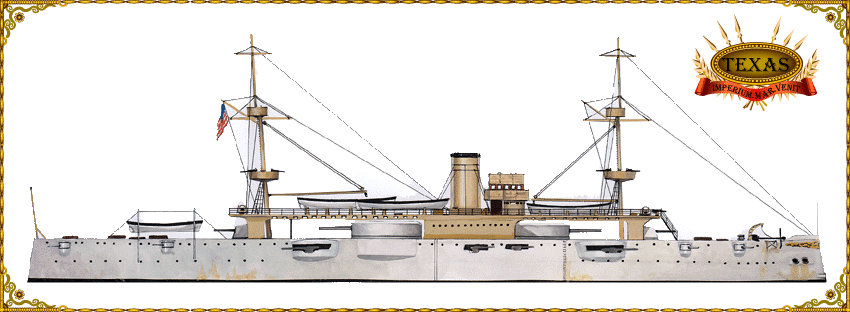
Although she was laid down in 1889 and launched in june 1892 at Norfolk NYd, after the Maine, whe was commissioned earlyer, thus gaining the title of first american battleship. Texas fought at the battle of Santiago. This first battleship was relatively weak in european standards, with two single-gunned en echelon turrets. Fought at Santiago, but not seriously tested.
- Weight & dimensions : 6135 t (6665 t FL); 94,13 x 19,53 x 6,86 m
- Propulsion : 2 shafts VTE, 4 cyl Boilers, 8600 hp, 17 knots.
- Armour : Harvey NS 12in protective deck,Turrets 12in, hoists 6in, CT 12in
- Armament : 2×1 12in (305 mm), 6-6in (152 mm), 12-6pdr (57 mm), 6-1pdr (37 mm) QF guns, 4 356 mm TT.
- Crew : 508
USS BALTIMORE (1888)
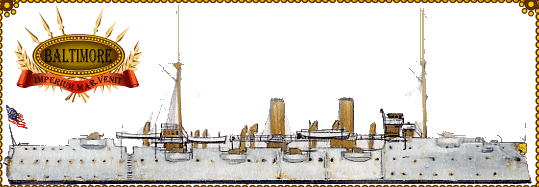
USS Baltimore was given the number C3 (older Chicago and Atlanta class were not included in this nomenclature, and authorized in august 1883. In fact she was based on the losing plans of the Elswick design for the Reina Regente, with a high freeboard, aprotective deck about 2,5 to 3 inches and a main armament of 8 in and 6 in guns. Launched in 1888 at Cramp, NY and commissioned in 1890, this cruiser was seen as the most successful design of the 1880s. This ship played no part in the 1898 war, and was rearmed in 1900-1903 with an all-6 in/40 mk.VII armament (seven guns, height amidship and four on the poop and forecastle. She was used as a minalyer in the Atlantic in WW1 decommissioned in 1922 but not sold prior to 1942.
- Weight & dimensions : 4413 t (5436 t FL) ; 102,11 x 14,78 x 5,94 m
- Propulsion : Steam only – 2 shafts, 2 HTE Compound engine, 4 boilers, 10750 hp, 19 knots.
- Blindage : Deck 2,5 in, 4 in amidships, 3 in conning tower.
- Armament : Four 8 in (203 mm), six 6 in (152 mm), four 75 mm, two 47 and two 37 mm QF.
- Crew : 386
USS COLUMBIA (1892)
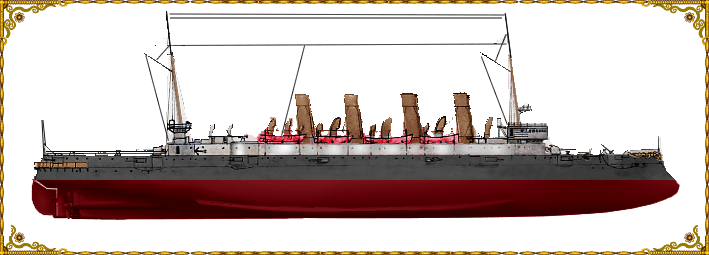
This class of cruisers built at Cramp with a year between respective commission were approved in 1890 and designed as commerce raiders, with a good speed and great autonomy. They differed by their funnels arrangement, Minneapolis having two of them. However they were often considered undergunned for their size. A class of cruisers which were relatively good steamers, Columbia for example was able to cross the atlantic, from Southampton to Sandy hook in just six days 23 hours, although they had a high coal consumption which led to decommission them from 1907 to 1915.
- Weight & dimensions : 7357 t (8270 t FL); 125,90 x 17,72 x 6,88 m
- Propulsion : 3 shafts VTE, 8 cyl Boilers, 21 000 hp, 21 knots.
- Armour : Belt 2,5-4in, turrets 4in, secondary 2in, CT 5in
- Armament : One 8in/40 Mk.III (203 mm), Two 6i/40n (152 mm), eight 4in/40 (152 mm), 12-6pdr (75 mm), 4-1pdr (37 mm QF) four 457 mm sub TT.
- Crew : 477
USS OLYMPIA (1892)
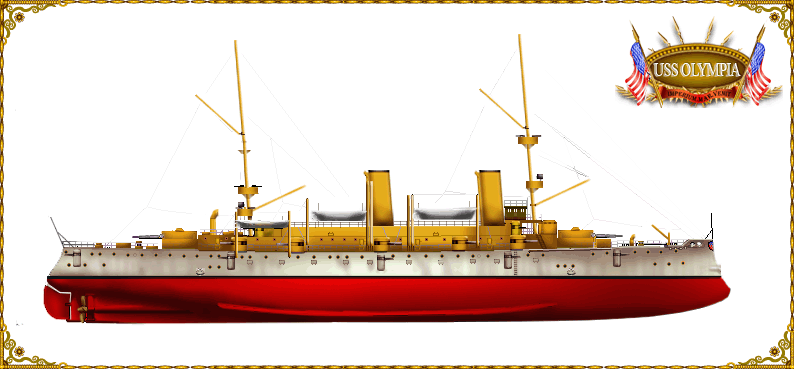
The cruiser USS Olympia was the most famous during in the entire war, as beeing the flagship of Commodore Dewey, the Hero of the battle of Manilla. She was relatively fast but small and cramped, and not seriously tested during the battle. Authorized in 1888, built at Union Iron Works in 1891-92 and commissioned in 1895, this cruiser was brand new when the war erupted. Protection was guaranteed by 3,5 to 4,5in Harvey nickel steele plates, which would have been probably not sufficient against some spanish ships. However the engines room was well protected by a 4in glacis. She was a good steamer, capable of 17 300 hp on forced draught, giving 21,7 knots. She is famous for beeing the flagship of Commodore Dewey, leading the American squadron in Manila harbor. She is now the only preserved warship of its kind in the world, and can be seen in the Independence Seaport Museum, philadelphia PA.
- Weight & dimensions : 5862 t (6558 t FL); 104,78 x 16,15 x 6,55 m
- Propulsion : 2 shafts VTE, 6 cyl Boilers, 13 5000 hp, 20 knots.
- Armour : Harvey belt 3 in, barbettes 4,5 in, turrets 3,5 in, secondary 4 in, CT 5 in
- Armament : Four 8in (203 mm), ten 5in (127 mm), fourteen 6pdr (57 mm), six 1pdr (37 mm QF) and six 457 mm aw.
- Crew : 411
USS FOOTE (1896)

The USS Foote was one of a serie of three torpedo boats, built in 1896 at Columbian Iron Works. They fought during the 1898 war at Cuba and survived WW1. This class was preceded by the US Ericsson (1894) and USS Cushing (1890), both deriving from the experimental Stiletto, the first American Torpedo boat. They were seaworthy but short range boats, with a better speed than previous boats, and fought at Cuba. However, the following Porter (two ships launched in 1897) were faster and better armed. These were all the Tbs available when war broke out.
- Weight & dimensions : 142 t (155 t FL); 48,76 x 4,91 x 1,52 m
- Propulsion : 2 shafts VTE, 2 cyl Thornycroft/Mosher Boilers, 3200 hp, 25 knots.
- Armour : none
- Armament : Three 1pdr (37 mm QF) and three 457 mm TT.
- Crew : 20
USS IOWA (1897)
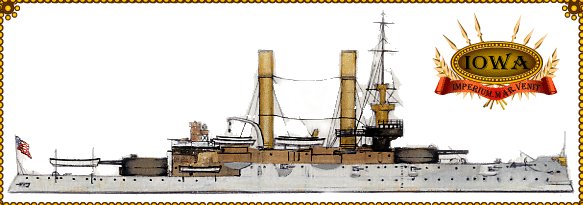
This battlehip, the BB4, was launched at Cramp in 1896 and commissioned in june 1897, prior to the war. She was generally similar to the previous Indiana class, but with a better distribution of armor, and more powerful, beeing 1 knot faster. She played her part but was not seriously tested during the battle of Santiago. This unique battleship was an improvement of the preview Indiana class. She was better protected and faster, capable of 17,1 knots with forced draught, and recoignisable with its tall funnels. She fought at Santiago, and received a cage foremast in 1909, and its 6 pdrs and TT removed to make way to four 4 in guns. She made some patrols in the atlantic during WW1, was decommissioned in 1919 and used as a radiocontrolled target ship, beeing finally sunk in 1923.
- Weight & dimensions : 11 410 t (12 647 t FL); 110,47 x 22 x 7,32 m
- Propulsion : 2 shafts VTE, 5 cyl Boilers, 11000 hp, 16 knots.
- Armour : Harvey belt 14 in, barbettes 15 in, turrets 17 in, secondary 8 in, CT 10 in
- Armament : 2×2 12in (305 mm), 4×2 8in (203 mm), six 6in (152 mm), 20-6pdr (57 mm), 4-1pdr (37 mm QF) and four 356 mm sub TT.
- Crew : 654
USS Oregon (1897)
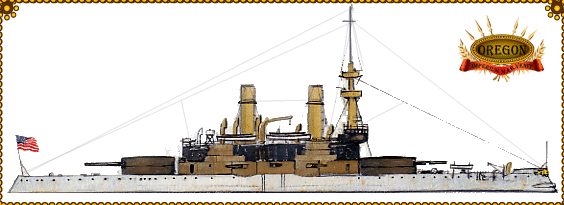
The USS Oregon was one of the three Indiana class battleships, authorized under the act of 30.6.1890. This “new navy” prototype was in reality not very successful as for its severe limitations in displacement that hampered some characteristics, like the low freeboard. One one ships turrets were unbalanced with hydraulic training and steam on the two others. They had two chimneys and a military foremast. USS Indiana, Massachusetts and oregon were laid down in 7.5, 25.6 and 19.11 1891, launched in 1893 and commissioned in 1895 (Indiana) and 1895 for the two others. Indiana and Oregon took part in the battle of Santiago but were not seriously tested.
- Weight & dimensions : 11 288 t (11 688 t FL); 106,95 x 21,10 x 7,32 m
- Propulsion : 2 shafts VTE, 6 cyl Boilers, 9000 hp, 15 knots.
- Armour : Harvey belt 18 in, barbettes 17 in, turrets 15 in, secondary 8 in, CT 9 in
- Armament : 2×2 12in (330mm), 4×2 8in (203 mm), four 6in (152 mm), twenty 6pdr (57 mm), six 1pdr (37 mm QF) and six 356 mm sub TT.
- Crew : 586-636
USS VESUVIUS (1891)
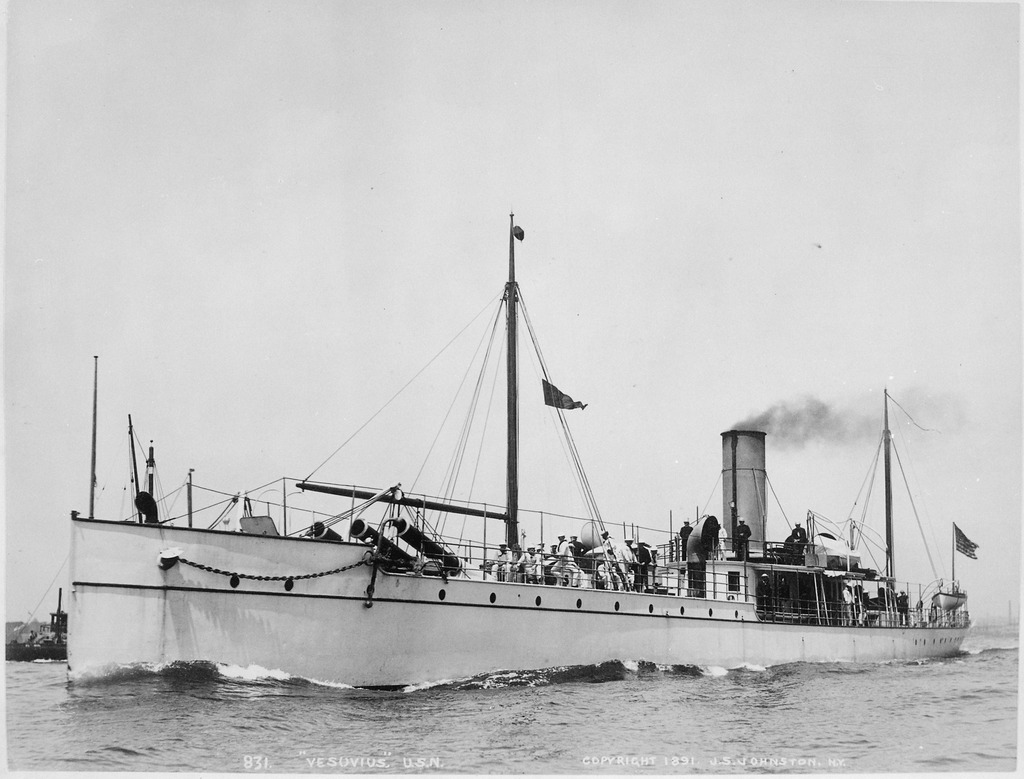
The “dynamite gun cruiser” tested pneumatic power to project 15-inch (38-cm) shells. An invention by D. M. Medford, it was developed by US Army officer (ret.) Edmund Zalinski. The range was limited to a mile or about 1.6 km, so basically the “cruiser” was a costal gunboat ideal to fire on fixed positions, the entire hull turned to face the objective as there was no traverse.
USS Vesuvius served during the Spanish-American War in 1898, shelling objectives in Cuba, with the advantage of not being heard at a distance, therefore making counter-battery fire difficult for the Spaniards. However due to high maintenance, the concept was dropped after the war, although the ship was in reserved at Boston Navy Yard until 1904, modified as a torpedo-testing vessel, and damaged in May 1915, repaired and in srvice until 1921.
The Spanish Armada in 1898
ALFONSO XII (1887)
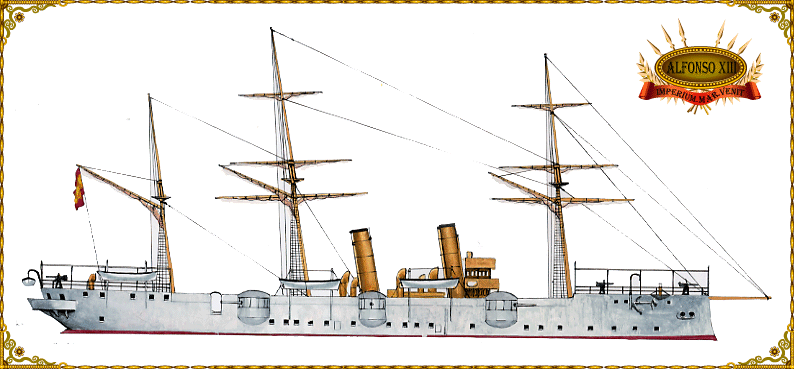
The three ships of the class Alfonso XII, were built in Spain from 1881 to 1888, the final delivery slipping largely beyond schedule due to lack of materials. Lightweight ships, they were mostly wooden hulled, reinforced with steel, they did not have armor but 12 watertight compartments along the waterline. Large 162 mm Hontoria guns were mounted laterally barbettes, and they had their fixed torpedo tubes, two in the stern, one in the bow, and two lateral, all submarines. Exceeded in 1898, they were nonetheless in use, the Alfonso XII and the Reina Mercedes are both on the mainland, and the Reina Cristina in Manila. There was also sunk by the American squadron on 1 May 1898. The other two survived until 1900 and 1907.
- Weight & dimensions : 3042 t ; 84,42 x 13,22 x 10,60 m
- Propulsion : Steam only – 1 screw, 1 TE Compound engine, 8 boilers, 4400 hp, 17 knots.
- Blindage : sides max 13 mm steel plating on oak.
- Armament : Six 152 mm, height 57 mm, six 47 mm QF, five 356 mm TT sub.
- Crew : 370
ARAGON (1878)
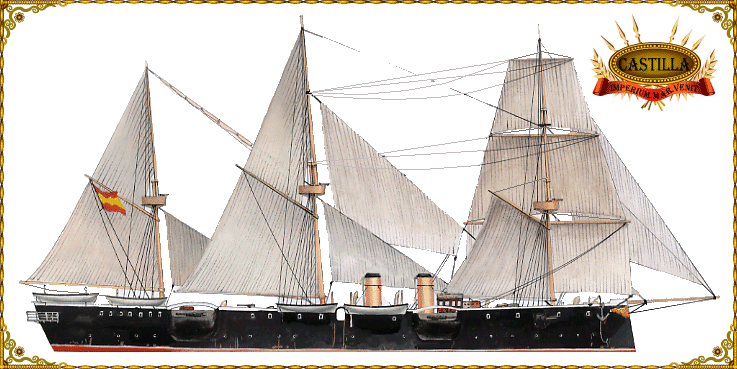
These three ships were designed in Spain in 1875, originally as second-class battleships. But by their weak protection and light weaponry upon a wooden construction, they appeared soon more suited as cruisers. Their construction lasted so long (launched in 1879, 1881, and completed in 1885-87) that they were nearly obsolete, retaining their venerable Armstrong smoothbore muzzle-loading 6 inches guns.
Classified as fast unprotected cruisers, or second-class cruisers, Aragon, Navarra and Castilla, built in Cartagena, Ferrol and Cadiz, they differed in weaponry, Aragon artillery was made of 6 162 mm Hontorio ML, while the two others had four Krupps of the same caliber, like their artillery left, smaller guns. The Castilla was sunk at the Battle of Manila in 1898, where she played a minor role (anchored in the harbor but deprived of its propellers, the hull protected by two rotting barges filled with sand…) and the others were withdrawn from service in 1905 and later for the Navarra, who ended her career as a training ship in 1900.
- Weight & dimensions : 3289 t; 71,93 x 13,41 x 7,20 m
- Propulsion : Sail and steam – 1 screw, Compound 3cyl TE engine, 4 Boilers, 4400 hp, 14 knots.
- Armour : Max sides 25 mm
- Armament : Four 5in (125 mm), Two 4in (120 mm), Two 7pdr and two 6pdr (87 and 76 mm), Ten 7,7 mm Mgs, two 356 mm TT.
- Crew : 392
CRISTOBAL COLON (1897)
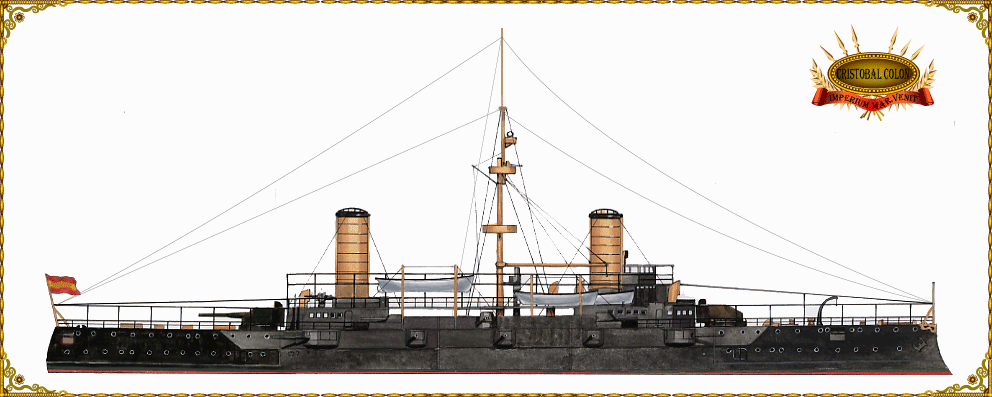
The Colon was a last-minute acquisition to strengthen the fleet of Cuba. She was one of the few Italians armored cruisers successful in export (two in Japan, one in Spain, four in Argentina, in addition to the three Italians). So she was related to the Garibaldi, but had some specific features, including two 254 mm single mounts guns (one front and one rear instead of the twin 203 mm turrets). She was originally built in Genoa by Ansaldo shipyards, christened as Giuseppe Garibaldi (second in this class named after this famous national hero…) and redeemed before completion. Two 254 mm guns were to be fitted on paper, but only one when she was issued before May 16, 1897. She fought and was sunk at the Battle of Santiago de Cuba, the last Italian cruiser to escape the American “trap” at the mouth of the bay, briefly duelling with the battleship USS Iowa, which lost sight of, the much faster Colon, defending herself with the single 254 mm left. But she was finally caught off coast (see Battle of Santiago de Cuba, 03/07/1898), and sunk.
- Weight & dimensions : 7230-7980t FL ; 111,76 x 18,22 x 7,10 m
- Propulsion : 2 shafts, 1 VTE engine, 24 Boilers, 14700 hp, 20 knots.
- Armour : 138 to 50 mm
- Armament : Single 8in (254 mm), 14 6in (152 mm), Ten 6pdr (76 mm), two MGs, four 450 mm TT.
- Crew : 370
EMPERADOR CARLOS V (1895)
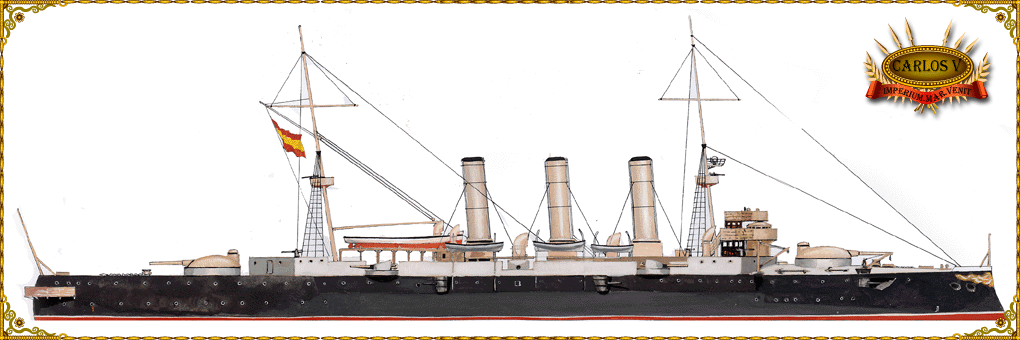
She was one of the most powerful ship in the spanish navy in 1898. However she was based in Spain and never had any opportunity to take action against the US fleet. This large and fast ship was built at Cadiz naval yard, and commissioned in 1898. However, she never took action against the U.S. Navy and served in 1914-18 in spain, mainly as gunnery training ship, beeing eventually scrapped in 1933.
- Weight & dimensions : 9090t FL ; 115,82 x 20,42 x 7,62 m
- Propulsion : 2 shafts, 4 cyl VTE engine, 4 Boilers, 18500 hp, 20 knots.
- Armour : Bulkhead 240 mm, sides 160 mm, decks 51 mm, CT 305 mm
- Armament : Two 11in (280 mm), eight 5,5in (140 mm), four 4,1in (100 mm), four 2pdr, one 1pdr QF guns, 2 Mgs, six 14in (356 mm) TT.
- Crew : 600
AUDAZ/FUROR CLASS (1896)

Involved with the squadron of Cuba, the Furor, Terror and Pluto were in Santiago when the American squadron of Admiral Schley came to the pass leading to the port. The fierce battle that ensued saw the destruction of two of these units, the Furor and Pluton, the second after a brief but homeric artillery duel with armed yacht USS Gloucester, and then attacked by the larger guns of the main warships. The Terror was the only survivor of the fleet of Admiral Cervera. Her speed saved her. Of good construction, the other four remained in service well after the Great War: They were disarmed and demolished in 1924-31, after serving in mine-layers. The Furor and Terror were british-built, at Clydebank NY, resembling the “27 knotters”, the standard destroyers of the Royal Navy. However, they were faster and more powerful. The following year, the very same yard produced the Audaz class on the eve of the Spanish-American War. They were the Audaz, Osado, Pluto and Porcupine, and had more to do with the “30 knotters”. However they were fitted with Normand french built boilers, and Porcupine has two funnels.
- Weight & dimensions : 400t FL ; 66,6 x 6,88 x 1,80 m
- Propulsion : 2 shafts, 3cyl TE engine, 4 Norman Boilers, 7500 hp, 30 knots.
- Armament : Two 2,5in (85 mm), four 2pdr, 2 Maxim 20 mm Mgs, two 12in (305 mm) TT.
- Crew : 67
ISLA DE LUZON CLASS (1886)
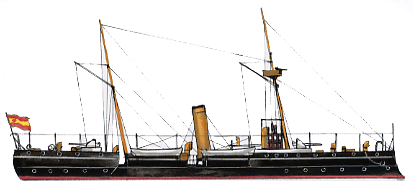
They were captured and recommissioned by the Americans and returned to service without change of name, but delivered as a white colonial gunboats, a rank corresponding to the reality of their dimensions. They served for Uncle Sam until 1920 for the Isla de Luzon, Isla de Cuba is sold in Venezuela in 1912. He served in the new building until 1918, and reset, renamed Mariscal Sucre yet He served until 1920. The city remained in Ensenada. She was decommissioned on an unknown date. These three tiny and unprotected cruisers, were built in Britain (Armstrong), launched in November and December 1886 for the first two, Isla de Luzon and Isla de Cuba, and Ensenada in 1887, completed much later in 1892. The first two were all scuttled at the Battle of Manila, May 1, 1898.
- Weight & dimensions : 1030t FL ; 56,11 x 8,87 x 3,84 m
- Propulsion : 2 shafts, 2 HTE engines, 2 Boilers, 1897-2697 hp, 14/15,9 knots.
- Armour : Decks, sides, 45 mm
- Armament : Two 4,7in (120 mm), four 2pdr, 2 Nordenfelt 25 mm Mgs, three 12in (305 mm) TT.
- Crew : 164
JORGE JUAN (1876)
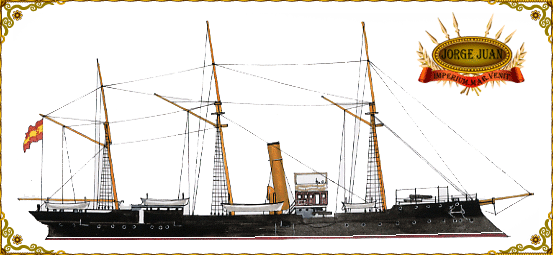
In 1898 they had their sails removed. The Barcaiztegui was wrecked after hitting a reef off Cuba in 1895 and Jorge Juan remained in Spain during the war. He was laid up at unknown date, probably before the First World War. These two wooden ships, rigged as three-masted barquentines, Jorge Juan and Sanchez Barcaiztegui, were ordered at La Seyne Navy yard in Toulon and commissioned in 1877. They were the only sloops in service in the Spanish navy.
- Weight & dimensions : 920t FL ; 63,72 x 9 x 4,72 m
- Propulsion : 1 shaft, 1 HTE engine, 2 Boilers, 1100 hp, 13 knots.
- Armour : Decks, sides, 20 mm
- Armament : Six 4,9in (158 mm), Two 6pdr, 2 Nordenfelt 25 mm Mgs.
- Crew : 146
NUMANCIA (1865)

In 1895, Numancia masts were shortened. Then in 1897-98, the ship was entirely rebuilt at La Seyne. Her main mast was removed, her original masts replaced by two heavy french style military masts with gunned armored tops, and received new machines, giving 13 knots. But as she was ready, the Spanish-American War ended. Numancia was used as a Coastal defence ship and then training hulk until 1906 and never left the port after 1909. She remained in commission until the early 20s and was scrapped.
- Weight & dimensions : 7200t FL ; 96 x 17,37 x 8,22 m
- Propulsion : 1 shaft, 1 HTE engine, 6 Boilers, 6000 hp, 13 knots.
- Armour : Composite armour plating on oak hull, Sides, 280 mm, decks 80 mm, CT 250 mm
- Armament : Four 5,5in (163 mm), six 4,9in (140 mm), three 4,7in, twelve Nordenfelt 25 mm Mgs, two 305 mm TT sub.
- Crew : 400 (512 as training ship)
PELAYO (1893)
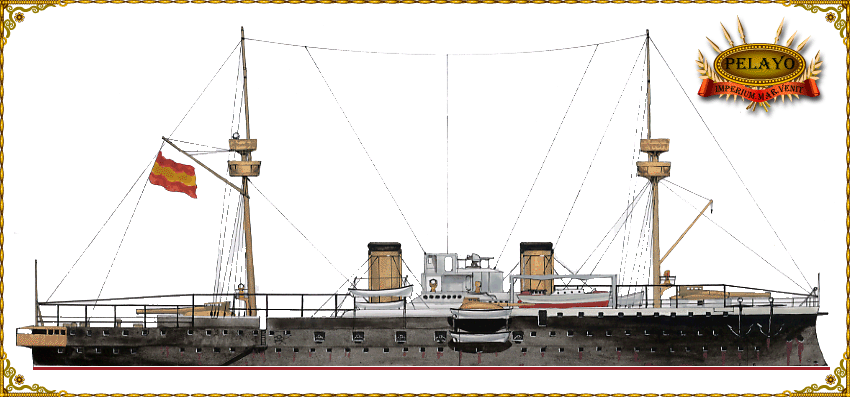
Despite its odd design, the Pelayo was the most modern of any Spanish battleship and its potent (although slow firing) 317 mm (12,5in) long-range Schneider-Creuzot guns were more than a match for any American battleship. Canet system allowed them to be loaded in any position. In 1897 she was refitted at La Seyne with 16 more effective Niclausse boilers. A more uniform 5,5in battery was fitted. However, despite its qualities, the Pelayo remained in Spain and took no part in the conflict. This relatively modern battleship was built in france at La Seyne in 1885-87 on French plans. With her typical lozange-like artillery and single turrets with Canet system, and sloping armor, she was not well-balanced comparing to the more homogeneous American counterparts.
- Weight & dimensions : 9745 t ; 102,04 x 20,20 x 7,58 m
- Propulsion : 2 shafts VTE, 12 Boilers, 9600 hp, 16,7 knots.
- Armour : Creusot steel – belt 11,5 in, barbettes 15in, shields 3in, CT 6,5in, decks 2,5in.
- Armament : Two 12,5in (317 mm), two 11in (280mm), one 6,4in (162 mm), Twelve 4,7in (120 mm), five 6pdr (57mm) QF Revolver, 14 Mgs, seven 356 mm sub TT.
- Crew : 520
ARIETE (1886)

Two Thornycroft-built torpedo-boat destroyers. Built in 1886-87 Thornycroft, two destroyers (Ariete and Rayo) first class, were the largest and fast in operation before the 1912 series. Commissioned in 1898, they were both lost by a wild fire in 1905 that was spread from one to another.
- Weight & dimensions : 3450 t ; 78,80 x 16 x 3,40 m
- Propulsion : Steam only – 2 screws, 2 Compound TE engines, 2 Boilers, 1300 hp, 26,5 knots.
- Armour : none
- Armament : Four 47 mm QF Revolver, two 356 mm bow TT, two spare torpedo reloads.
- Crew : 25
REINA REGENTE (1887)
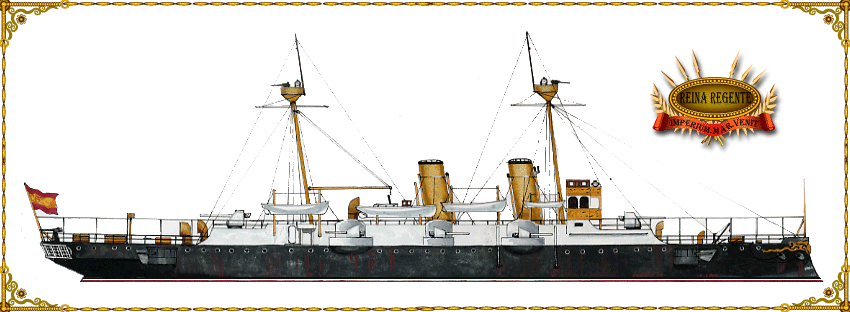
This class was also composed of Alfonso XIII (1891) and Lepanto (1892). The latter was completed in 1895. On trial they attained 18,5 knots their natural draught (20,5 knots on forced draught). Like the previous Alfonso XII, the construction of these cruiser slept largely beyond schedule as they took 6 years to be completed. Although bigger and more effective than the Alfonso XII, They were nearly obsolete on commission.
- Weight & dimensions : 4725 t ; 96,62 x 15,24 x 6,21 m
- Propulsion : 2 shafts HTE, 8 boilers, 11 500 hp, 20,5 knots.
- Armour : Decks 4,5in, sides 1in, gunshields 3in.
- Armament : Four 7,9in (200 mm), six 4,7in (120mm), six 6pdr (57 mm) QF, six 20 mm Nordenfett Mgs, five 356 mm TT sub.
- Crew : 440
TEMERARIO (1889)
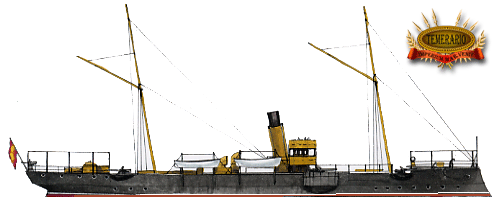
This class was also composed of Alfonso XIII (1891) and Lepanto (1892). The latter was completed in 1895. On trial they attained 18,5 knots their natural draught (20,5 knots on forced draught). Like the previous Alfonso XII, the construction of these cruiser slept largely beyond schedule as they took 6 years to be completed. Although bigger and more effective than the Alfonso XII, They were nearly obsolete on commission.
- Weight & dimensions : 562 t; 58 x 6,76 x 3,16 m
- Propulsion : 2 shafts VTE, 4 boilers, 2600 hp, 19 knots.
- Armour : Decks and bulkheads 1,5 in.
- Armament : Four 4,7in (120mm), four 6pdr (57 mm) QF, one 25 mm Nordenfett Mg, two 356 mm TT.
- Crew : 91
VITORIA (1865)
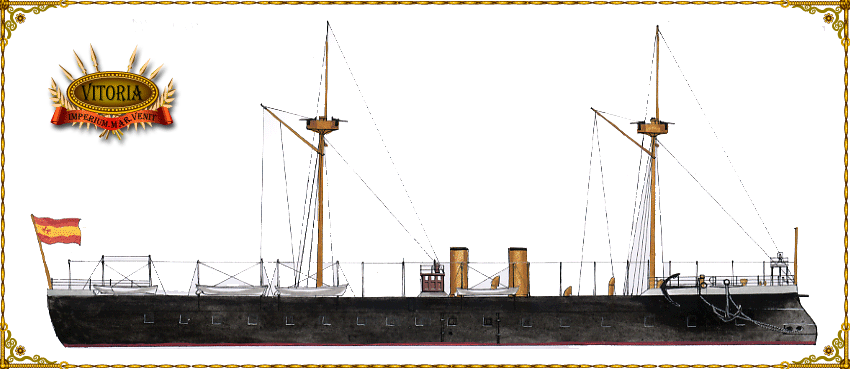
Originally she was designed to bear a thirty 68pdr SB guns (approx. 250mm) broadside, but plans were altered and she was completed with a central battery of eight 9in. After her rebuilding at La Seyne, she was fitted with two military masts with small armoured tops for light Mgs. She was used as costal battleship, then training ship in 1900 to an unknown date. This sole centre battery Ironclad was built by Thames iron Works in 1863-65 and commissioned in 1866. In 1897-98 she was entirely rebuilt at La Seyne and re-commissioned too late to take part in the conflict, with the following specifications.
- Weight & dimensions : 1152 t; 64 x 9,75 x 4,20 m
- Propulsion : 1 shaft HC, 4 cyl boilers, 1500 hp, 13 knots.
- Armour : none.
- Armament : Four 4,7in (120mm), four 6pdr (57 mm) QF, one 25 mm Nordenfett Mg, two 356 mm TT.
- Crew : 173
VIZCAYA (1890)
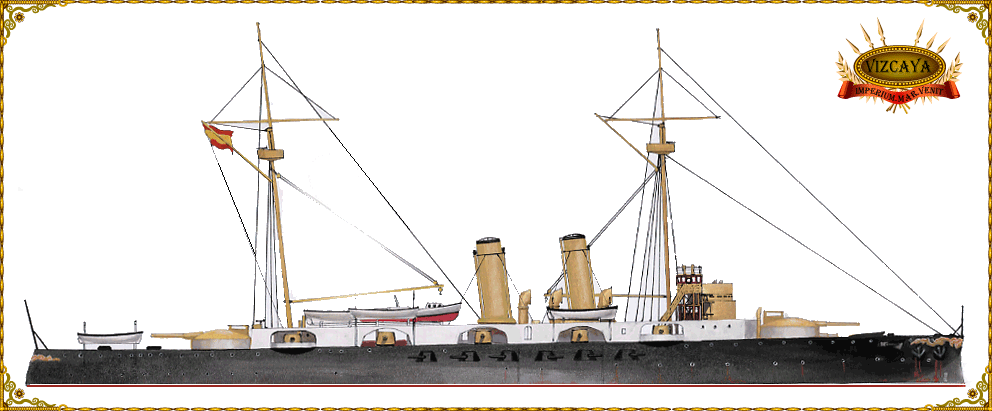
Completed in 1890-91 they were some of the most heavily armed cruisers in the world and posed a real threat for the American fleet. However, if their protection was thick, it was not well-distributed. The armoured belt extended only two third of the total length and was narrow, the protective deck was flat and curved in the extremities but low-based, and consequently their high unprotected freeboard suffered badly during the battle of Santiago were all three were sunk. The Infanta Maria Teresa (or Vizcaya) class formed the bulk of the armoured cruiser force during the war. The class comprised also Vizcaya and Almirante Oquendo, all built at Bilbao. With a good balance of protection, armament, speed, they were seen as the best spanish warships in 1898.
- Weight & dimensions : 6890 t; 110,94 x 19,87 x 6,6 m
- Propulsion : 2 shafts VTE, 8 cyl boilers, 13700 hp, 20,2 knots max.
- Armour : Belt 10-12in, barbettes 9in, CT 12in, decks 2-3in.
- Armament : Two 11in (280 mm), Ten 5,5in (155 mm), eight 12pdr (76 mm), ten 3pdr (37 mm) QF Hotchkiss revolver, eight 25 mm Nordenfelt and two maxim Mgs, eight 356 mm TT sub.
- Crew : 484

 Latest Facebook Entry -
Latest Facebook Entry -  X(Tweeter) Naval Encyclopedia's deck archive
X(Tweeter) Naval Encyclopedia's deck archive Instagram (@navalencyc)
Instagram (@navalencyc)





 French Navy
French Navy Royal Navy
Royal Navy Russian Navy
Russian Navy Armada Espanola
Armada Espanola Austrian Navy
Austrian Navy K.u.K. Kriegsmarine
K.u.K. Kriegsmarine Dansk Marine
Dansk Marine Nautiko Hellenon
Nautiko Hellenon Koninklije Marine 1870
Koninklije Marine 1870 Marinha do Brasil
Marinha do Brasil Osmanlı Donanması
Osmanlı Donanması Marina Do Peru
Marina Do Peru Marinha do Portugal
Marinha do Portugal Regia Marina 1870
Regia Marina 1870 Nihhon Kaigun 1870
Nihhon Kaigun 1870 Preußische Marine 1870
Preußische Marine 1870 Russkiy Flot 1870
Russkiy Flot 1870 Svenska marinen
Svenska marinen Søværnet
Søværnet Union Navy
Union Navy Confederate Navy
Confederate Navy Armada de Argentina
Armada de Argentina Imperial Chinese Navy
Imperial Chinese Navy Marinha do Portugal
Marinha do Portugal Mexico
Mexico Kaiserliche Marine
Kaiserliche Marine 1898 US Navy
1898 US Navy Sovietskiy Flot
Sovietskiy Flot Royal Canadian Navy
Royal Canadian Navy Royal Australian Navy
Royal Australian Navy RNZN Fleet
RNZN Fleet Chinese Navy 1937
Chinese Navy 1937 Kriegsmarine
Kriegsmarine Chilean Navy
Chilean Navy Danish Navy
Danish Navy Finnish Navy
Finnish Navy Hellenic Navy
Hellenic Navy Polish Navy
Polish Navy Romanian Navy
Romanian Navy Turkish Navy
Turkish Navy Royal Yugoslav Navy
Royal Yugoslav Navy Royal Thai Navy
Royal Thai Navy Minor Navies
Minor Navies Albania
Albania Austria
Austria Belgium
Belgium Columbia
Columbia Costa Rica
Costa Rica Cuba
Cuba Czechoslovakia
Czechoslovakia Dominican Republic
Dominican Republic Haiti
Haiti Hungary
Hungary Honduras
Honduras Estonia
Estonia Iceland
Iceland Eire
Eire Equador
Equador Iran
Iran Iraq
Iraq Latvia
Latvia Liberia
Liberia Lithuania
Lithuania Mandchukuo
Mandchukuo Morocco
Morocco Nicaragua
Nicaragua Persia
Persia San Salvador
San Salvador Sarawak
Sarawak Uruguay
Uruguay Venezuela
Venezuela Zanzibar
Zanzibar Warsaw Pact Navies
Warsaw Pact Navies Bulgaria
Bulgaria Hungary
Hungary

 Bundesmarine
Bundesmarine Dutch Navy
Dutch Navy Hellenic Navy
Hellenic Navy Marina Militare
Marina Militare Yugoslav Navy
Yugoslav Navy Chinese Navy
Chinese Navy Indian Navy
Indian Navy Indonesian Navy
Indonesian Navy JMSDF
JMSDF North Korean Navy
North Korean Navy Pakistani Navy
Pakistani Navy Philippines Navy
Philippines Navy ROKN
ROKN Rep. of Singapore Navy
Rep. of Singapore Navy Taiwanese Navy
Taiwanese Navy IDF Navy
IDF Navy Saudi Navy
Saudi Navy Royal New Zealand Navy
Royal New Zealand Navy Egyptian Navy
Egyptian Navy South African Navy
South African Navy






























 Ukrainian Navy
Ukrainian Navy dbodesign
dbodesign